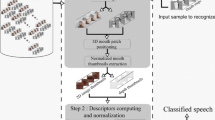Abstract
This paper proposes a method of tracking the lips in the system of audio-visual speech recognition. Presented methods consists of a face detector, face tracker, lip detector, lip tracker, and word classifier. In speech recognition systems, the audio signal is exposed to a large amount of acoustic noise, therefor scientists are looking for ways to reduce audio interference on recognition results. Visual speech is one of the sources that is not perturbed by the acoustic environment and noise. To analyze the video speech one has to develop a method of lip tracking. This work presents a method for automatic detection of the outer edges of the lips, which was used to identify individual words in audio-visual speech recognition. Additionally the paper also shows how to use video speech to divide the audio signal into phonemes.
Access this chapter
Tax calculation will be finalised at checkout
Purchases are for personal use only
Preview
Unable to display preview. Download preview PDF.
Similar content being viewed by others
References
Shin, J., Lee, J., Kim, D.: Real-time lip reading system for isolated Korean word recognition. Pattern Recognition 44, 559–571 (2011)
Neti, C., Potamianos, G., Luttin, J., Mattews, I., Glotin, H., Vergyri, D., Sison, J., Mashari, A., Zhou, J.: Audio Visual Speech-Recognition. 2000 Final Report (2000)
Zhi, Q., Kaynak, M.N.N., Sengupta, K., Cheok, A.D., Ko, C.C.: A study of the modeling aspects in bimodal speech recognition. In: Proc. 2001 IEEE International Conference on Multimedia and Expo, ICME 2001 (2001)
Jian, Z., Kaynak, M.N.N., Cheok, A.D., Chung, K.C.: Real-time Lip-tracking For Virtual Lip Implementation in Virtual Environments and Computer Games. In: Proc. 2001 International Fuzzy Systems Conference (2001)
Petajan, E.: Automatic lipreading to enhance speech recognition. In: Proceedings of Global Telecommunications Conference, Atlanta, GA, pp. 265–272 (1984)
Bailly, G., Vatikiotis-Basteson, E., Pierrier, P.: Issues in Visual Speech Processing. MIT Press (2004)
Park, S., Lee, J., Kim, W.: Face Recognition Using Haar-like feature/LDA. In: Workshop on Image Processing and Image Understanding, IPIU 2004 (January 2004)
Hong, K., Min, J.-H., Lee, W., Kim, J.: Real Time Face Detection and Recognition System Using Haar-Like Feature/HMM in Ubiquitous Network Environments. In: Gervasi, O., Gavrilova, M.L., Kumar, V., Laganá, A., Lee, H.P., Mun, Y., Taniar, D., Tan, C.J.K. (eds.) ICCSA 2005. LNCS, vol. 3480, pp. 1154–1161. Springer, Heidelberg (2005)
Kukharev, G., Kuzminski, A.: Biometric Technology, Part. 1: Methods for Face Recognition. Szczecin University of Technology, Faculty of Computer Science (2003) (in Polish)
Choraś, M.: Human Lips as Emerging Biometrics Modality. In: Campilho, A., Kamel, M.S. (eds.) ICIAR 2008. LNCS, vol. 5112, pp. 993–1002. Springer, Heidelberg (2008)
Kaynak, M.N.N., Zhi, Q., Cheok, A.D., Sengupta, K., Chung, K.C.: Audio - Visual Modeling for Bimodal Speech Recognition. In: Proc. 2001 International Fuzzy Systems Conference (2001)
Liu, X., Zhao, Y., Pi, X., Liang, L., Nefian, A.V.: Audio-visual continuous speechr ecognition using a coupled hidden Markov model. In: ICSLP 2002, pp. 213–216 (2002)
Hasegawa-Johnson, M., Livescu, K., Lal, P., Saenko, K.: Audiovisual speech recognition with articulator positions as hidden variables. In: Proc. International Congress of Phonetic Sciences (ICPhS) (2007)
Shao, X., Barker, J.: Stream weight estimation for multistream audio-visual speech recognition in a multispeaker environment. Speech Communication 50, 337–353 (2008)
Nefian, A.V., Liang, L., Pi, X., Xiaoxiang, L., Mao, C., Murphy, K.: A coupled HMM for audio-visual speech recognition. In: IEEE International Conference on Acoustics, Speech, and Signal Processing, ICASSP (2002)
Nefian, A.V., Liang, L., Pi, X., Liu, X., Mao, C.: An coupled hidden Markov model for audio-visual speech recognition. In: International Conference on Acoustics, Speech and Signal Processing (2002)
Author information
Authors and Affiliations
Editor information
Editors and Affiliations
Rights and permissions
Copyright information
© 2012 Springer-Verlag Berlin Heidelberg
About this paper
Cite this paper
Kubanek, M., Bobulski, J., Adrjanowicz, L. (2012). Lip Tracking Method for the System of Audio-Visual Polish Speech Recognition. In: Rutkowski, L., Korytkowski, M., Scherer, R., Tadeusiewicz, R., Zadeh, L.A., Zurada, J.M. (eds) Artificial Intelligence and Soft Computing. ICAISC 2012. Lecture Notes in Computer Science(), vol 7267. Springer, Berlin, Heidelberg. https://doi.org/10.1007/978-3-642-29347-4_62
Download citation
DOI: https://doi.org/10.1007/978-3-642-29347-4_62
Publisher Name: Springer, Berlin, Heidelberg
Print ISBN: 978-3-642-29346-7
Online ISBN: 978-3-642-29347-4
eBook Packages: Computer ScienceComputer Science (R0)




